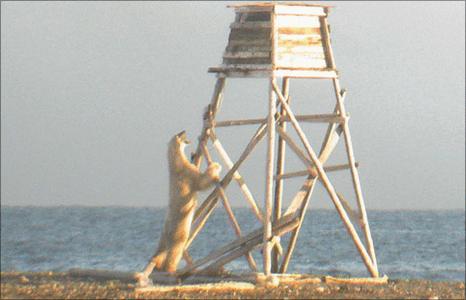Impact of hungry polar bears on Solway geese studied
- Published

Mr Morrell will be heading to Svalbard to monitor the impact of feeding polar bears on the barnacle goose population. Pic: Jouke Prop, BResearch, Netherlands
A study is to examine the impact of hungry polar bears in the Arctic on barnacle goose numbers in southern west Scotland.
The birds are regular visitors to the Solway coast in Dumfries and Galloway during the winter months.
However, their numbers are dwindling due to eggs being eaten by bears on the Arctic island of Svalbard.
Experts at the Wildfowl and Wetlands Trust said it could have "dire consequences" for the goose population.
Brian Morrell, of the trust's Caerlaverock centre, said offshore islands were once considered a safe place for the birds to breed but diminishing polar ice has been blamed for a rise in bear numbers in the area.
"Polar bears in Svalbard are now feeding on barnacle goose eggs, wiping out entire island nest colonies," said Mr Morrell.
"One theory gaining acceptance is that the bears are now unable to reach the seal colonies to feed during the summer.
"This could have dire consequences for these geese, the whole population of which winter on the Solway Firth."
'Quite sobering'
Barnacle goose numbers have risen in south west Scotland from fewer than 300 birds in the late 1940s to about 30,000 birds in 2010, thanks to long-running conservation efforts.
However, last winter only half the expected numbers of goslings were seen on the Solway.
Now Mr Morrell is to join a Dutch team from the University of Groningen to monitor polar bear impact on the nest colonies in Svalbard.
"I am looking forward to returning to Svalbard to see the barnacle geese at their breeding grounds," he said.
"But the fact that there could be so many hungry bears in the study area is quite sobering.
"However, we will be well equipped and trained for any eventuality."